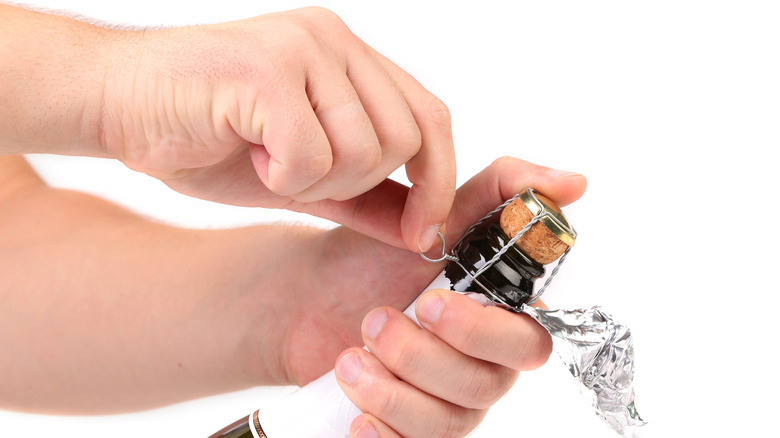Drinking Champagne Is Actually Supposed To Be Less Fun
There are two types of Champagne drinkers: those who enjoy drinking it and those who prefer to dance in it post-explosion as it rains down on them from above. No matter which fancy method of merriment suits you more, sipping a bubbly Champagne is a celebratory staple that has been a thing for centuries.
From grand European parties and religious ceremonies to your average date night and birthday bash, having a bottle of Champagne ready for the popping has become a much more common luxury over time. Though, maybe you don't reach for Champagne as your special drink of choice in an effort to avoid putting someone's eye out when the cork is released with a bang. Or, maybe you're the opposite and love taking the handheld cannon and giving it a good shake before unleashing all that fizzy spray.
But is popping Champagne really necessary? "Experts contend that a bottle of Champagne opened with skill will make only a very small popping sound, or perhaps none at all," explains Pursuitist. It turns out, there's a correct way to open Champagne, or at least a more efficient way that will ensure you get the best flavor, carbonation, and bang for your buck (minus the actual bang).
How to control a Champagne bottle's cork with your thumb
So how are you supposed to open a bottle of Champagne if you want to avoid losing all that precious drinkable foam after popping the cork? "I never open Champagne like that, and no sommelier will," Kathryn Coker, wine director of Esther's Wine Bar in Southern California, said to Food & Wine. Instead, she suggests putting your thumb on the cork while you open the bottle.
For the cleanest method, you can hold a towel in your dominant hand near the cork to absorb any spill as you cradle the base of the chilled bottle with the other hand. It's important to hold it at a 45-degree angle when opening, both for a safer approach and one that will reduce the chance of excess foam forming. "This angle will greatly reduce the loss of CO2 gas, resulting in the most vibrantly fizzy wine possible," explains Thrillist.
Keeping your thumb over the cork will give you more control over the whole process and avoid a frothy eruption. After twisting the bottle away from you, the cork should release a small hissing sound and land in your palm, perfectly crisp ready to pour and enjoy. Corks can shoot out of Champagne bottles at around 20 miles per hour, so if you aren't in the mood for a taste of danger and aren't trying to look cool, opening it this way is your best option.

